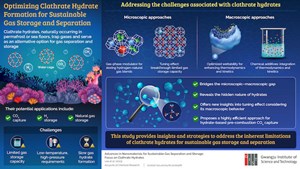News
Gwangju Institute of Science and Technology Researchers unveil strategies for sustainable gas storage and separation with clathrate hydrates
(PRNewswire)--Clathrate hydrates are ice-like nano porous compounds which consist of nano-sized water cages. They are found in places like permafrost or seabed. Moreover, their unique physical and chemical traits make them beneficial for various separation processes, such as capture of carbon dioxide (CO2) before and after combustion, storage of H2 gas, transportation of natural gas, desalination of wastewater and more.

However, using them in real-world applications is still a significant challenge as they have limited gas storage capacities and slow formation rates that require high pressure and low temperature conditions. In a new study led by Professor Youngjune Park from the Gwangju Institute of Science and Technology in Korea, a team of researchers has comprehensively reviewed recent research findings, including their own, that address these myriad challenges associated with clathrate hydrates.
According to Prof. Park, "By exploring the untapped potential of clathrate hydrates, we have effectively mitigated these limitations and provided efficient H2 storage solutions through the introduction of H2-natural gas blends into clathrate hydrates." Their study was made available online on 7 November 2023 and published in the journal Accounts of Chemical Research on November 21, 2023.
The team presents an account of macroscopic and microscopic approaches to bridge the gap between them. The microscopic approach includes techniques like using 'gas-phase modulators' to synthesize hydrates which enable concurrent storage of light hydrocarbons and H2 and prevent chemical waste generation. Tuning effects, which aid in maximizing gas storage capacity and promote thermodynamic stability, are also discussed. From a macroscopic viewpoint, the study included interfacial interactions with porous substances and how they accelerate kinetics to enhance hydrate formation. Additionally, rapid formation by chemical additives was also summarized.
This study thus helps to advance the untapped potential of gas hydrates by bridging macroscopic and microscopic properties, and the exploration of their hidden nature opens various potential applications. These encompass efficient techniques for pre- and post-combustion CO2 capture using hydrates, demonstrating practical and economic viability. Subsequently, this can reduce carbon dioxide emissions from power plants and thereby play a role in mitigating climate change in the long run and making carbon capture more affordable.
These insights will also help to increase the storage and transportation capacity of H2 and natural gas, which is crucial for industries involved in energy applications using these gases. "This research has significant long-term potential for the gas storage and separation industry, particularly in achieving carbon neutrality. Our findings offer crucial insights for developing clathrate hydrate-based technologies for H2 storage and carbon dioxide separation, essential for a future low-carbon society," emphasized Prof. Park.
Other sustainable applications include gas separation processes, as well as desalination processes, thereby providing an avenue for the treatment of water and other substances in industries requiring large-scale processing.

